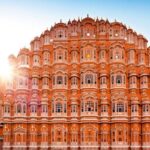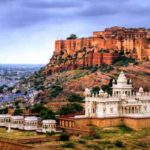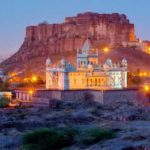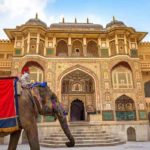List of 33 Best Tourist Places to visit in Rajasthan, known for its rich cultural heritage and historical significance, offers a plethora of tourist attractions. Jaipur, the capital city, is famous for its palaces like Hawa Mahal, Amber Fort, and City Palace. Udaipur, the “City of Lakes,” enchants visitors with its stunning Lake Pichola, City Palace, and Jag Mandir.
Jodhpur, the “Blue City,” boasts the majestic Mehrangarh Fort and the beautiful Umaid Bhawan Palace. Jaisalmer, the “Golden City,” is renowned for the Jaisalmer Fort, Patwon Ki Haveli, and its vast sand dunes. Pushkar, known for its sacred lake and the Brahma Temple, hosts the vibrant Pushkar Camel Fair.
Ranthambore National Park is a haven for wildlife enthusiasts, offering the chance to spot tigers in their natural habitat. Mount Abu, the only hill station in Rajasthan, provides a refreshing retreat with attractions like Nakki Lake and Dilwara Temples. Bikaner, with its Junagarh Fort and Karni Mata Temple, and Chittorgarh, home to the largest fort in India, round out the must-visit destinations in this enchanting state.
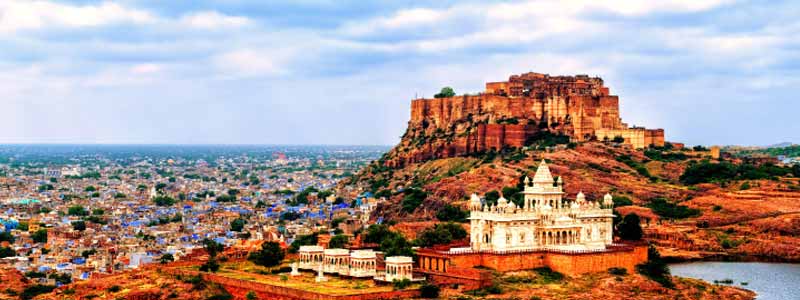
Mehrangarh Fort, Jodhpur
Mehrangarh Fort, perched 410 feet above the city of Jodhpur, is one of the largest and most magnificent forts in India. Founded by Rao Jodha in 1459, the fort offers breathtaking panoramic views of the “Blue City.” The fort’s formidable walls enclose a complex of palaces, courtyards, temples, and museums.
Inside, visitors can explore the intricately decorated palaces such as the Moti Mahal (Pearl Palace), Phool Mahal (Flower Palace), and Sheesh Mahal (Mirror Palace). These palaces showcase exquisite lattice work, vibrant frescoes, and ornate ceilings. The fort also houses a museum with an impressive collection of artifacts, including royal palanquins, weaponry, paintings, and costumes, offering a glimpse into the regal lifestyle of Rajasthan’s past.
The Chamunda Mataji Temple, dedicated to the goddess Chamunda, is another highlight within the fort. Mehrangarh Fort is not just a historical marvel but also a cultural hub, hosting various festivals and events, including the famous Rajasthan International Folk Festival. The fort’s robust architecture, rich history, and cultural significance make it a must-visit landmark in Jodhpur.
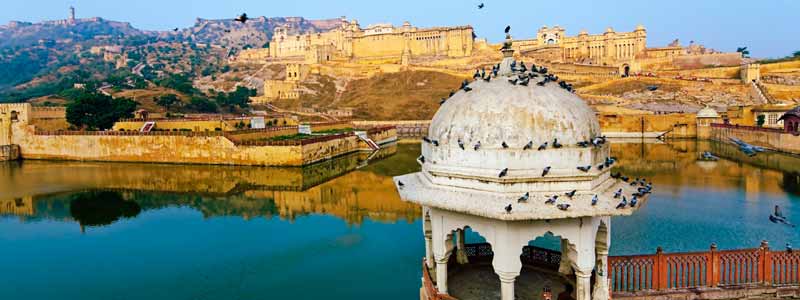
Amber Fort and Palace, Jaipur
Amber Fort and Palace, located in Jaipur, is a stunning example of Rajput architecture and a UNESCO World Heritage Site. Built in the late 16th century by Raja Man Singh I and later expanded by successive rulers, the fort is situated atop a hill overlooking Maota Lake, offering a picturesque setting.
The fort’s architecture is a blend of Hindu and Mughal styles, featuring large ramparts, series of gates, and cobbled paths. The main entrance, Suraj Pol (Sun Gate), leads to the Jaleb Chowk, the main courtyard. Inside the fort, the Diwan-i-Aam (Hall of Public Audience) and the Diwan-i-Khas (Hall of Private Audience) are notable for their ornate design and historical significance.
The Sheesh Mahal (Mirror Palace) is a highlight, with its intricate mirror work creating a dazzling effect when illuminated by light. The Sukh Niwas (Hall of Pleasure), with its cool climate created by a unique water system, and the Ganesh Pol, an intricately painted gate, are other attractions within the fort.
Elephant rides up the ramparts, light and sound shows in the evenings, and the panoramic views of Jaipur and its surroundings enhance the visitor experience. Amber Fort is not only a testament to the grandeur of Rajputana architecture but also a significant cultural and historical landmark in Jaipur.
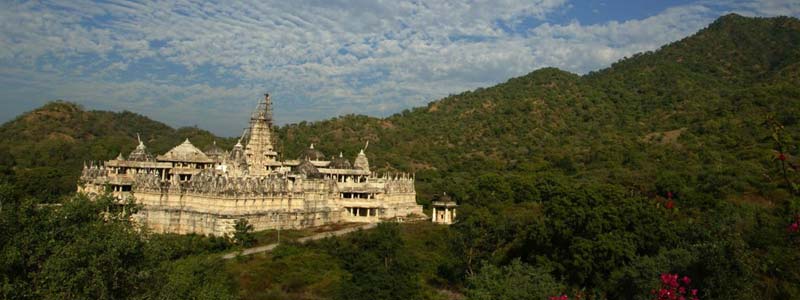
Jain Temple – Ranakpur, Udaipur
The Jain Temple in Ranakpur, located near Udaipur, is one of the most significant and stunning Jain temples in India. Dedicated to Tirthankara Adinatha, this temple is renowned for its intricate architecture and exquisite marble carvings. Built in the 15th century under the patronage of a local Jain businessman, Dharna Shah, and the support of Rana Kumbha, the ruler of Mewar, the temple exemplifies the grandeur of Jain architectural style.
The temple complex is set amidst the lush green Aravalli hills, offering a serene and tranquil environment. The main temple, also known as Chaumukha Temple, is designed in the form of a celestial vehicle and features 29 halls supported by 1,444 intricately carved marble pillars, each uniquely designed. The pillars are so skillfully crafted that no two are identical, and they create a mesmerizing play of light and shadow within the temple.
Inside the temple, the idol of Adinatha, the first Tirthankara, is housed in the sanctum, surrounded by numerous smaller shrines and domes. The ceilings are adorned with stunning geometric patterns, floral designs, and depictions of Jain mythology.
The Ranakpur Jain Temple is not only a place of worship but also a masterpiece of art and architecture, attracting devotees and tourists alike. Its serene ambiance, combined with its architectural brilliance, makes it a must-visit destination for those exploring the rich cultural heritage of Rajasthan.
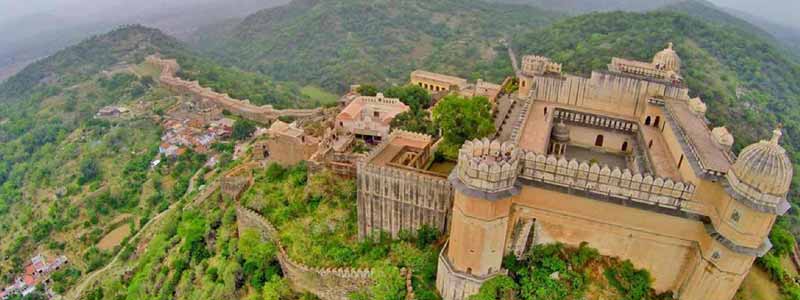
Kumbhalgarh Fort, Udaipur
Kumbhalgarh Fort, located near Udaipur in the Rajsamand district of Rajasthan, is a remarkable example of Rajput military architecture. Built by Rana Kumbha in the 15th century, the fort is perched atop the Aravalli hills, providing strategic defense and breathtaking views of the surrounding landscape. It is a UNESCO World Heritage Site, recognized for its historical and architectural significance.
The fort is most famous for its extensive and well-preserved wall, which stretches over 36 kilometers, making it the second-longest continuous wall in the world, after the Great Wall of China. This formidable structure, up to 15 feet wide, encloses the fort’s complex of palaces, temples, gardens, and water reservoirs.
Kumbhalgarh Fort houses more than 300 temples, including the significant Shiva Temple, which features a massive Shivalinga. The Badal Mahal (Palace of Clouds), located at the highest point of the fort, offers panoramic views and is divided into two sections: the Mardana Mahal (for men) and the Zanana Mahal (for women). The palace is adorned with beautiful paintings and elaborate architectural details.
The fort’s strategic location and robust construction allowed it to remain unconquered for centuries, serving as a refuge for Mewar rulers during times of war. The light and sound show held in the evenings narrates the fort’s history, bringing its past to life for visitors.
Kumbhalgarh Fort’s historical significance, architectural grandeur, and scenic beauty make it a must-visit destination for those exploring the rich heritage of Rajasthan.
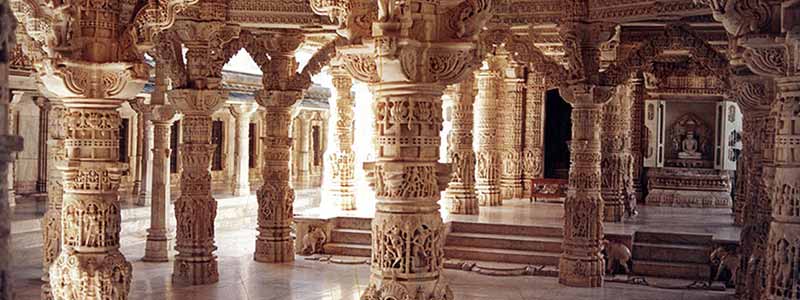
Dilwara Jain Temples, Mount Abu
The Dilwara Jain Temples in Mount Abu are renowned for their exceptional marble craftsmanship and intricate architectural design. Built between the 11th and 13th centuries, these temples are dedicated to various Tirthankaras and are considered some of the finest examples of Jain temple architecture in India.
The complex consists of five temples: Vimal Vasahi, Luna Vasahi, Pittalhar, Khartar Vasahi, and Mahavir Swami. Each temple is a masterpiece of marble artistry, featuring ornate carvings and detailed sculptures. The Vimal Vasahi Temple, built in 1031, is dedicated to the first Tirthankara, Adinatha, and is noted for its grand entrance and detailed pillars. The Luna Vasahi Temple, constructed in 1230, is dedicated to the 22nd Tirthankara, Neminatha, and is famous for its impressive marble work and elegant design.
The interiors of these temples are adorned with intricately carved pillars, ceilings, and walls, showcasing floral patterns, geometric designs, and mythological motifs. The meticulous craftsmanship creates an atmosphere of serenity and spiritual reverence.
The Dilwara Jain Temples are not only significant for their religious importance but also for their architectural brilliance, attracting visitors and scholars interested in Jain art and history. They offer a peaceful retreat and a glimpse into the artistic heritage of the Jain community.
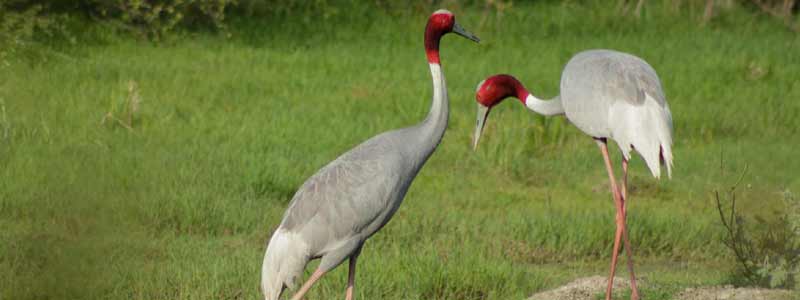
Keoladeo Ghana National Park, Bharatpur
Keoladeo Ghana National Park, located in Bharatpur, Rajasthan, is a renowned bird sanctuary and a UNESCO World Heritage Site. Spanning approximately 29 square kilometers, this park is a vital stopover for migratory birds and is known for its rich avian diversity. It was originally developed as a hunting ground by the Maharaja of Bharatpur in the 18th century before being transformed into a protected area for wildlife conservation.
The park is famous for its diverse bird species, with over 370 species recorded, including the rare Siberian crane, various species of storks, herons, and egrets. It is particularly significant during the winter months when migratory birds arrive, making it a paradise for birdwatchers and nature enthusiasts.
In addition to its avian inhabitants, Keoladeo Ghana National Park is home to a variety of other wildlife, including deer, wild boar, and various reptiles. The park’s landscape features a mix of grasslands, woodlands, and wetlands, providing diverse habitats for its inhabitants.
Visitors can explore the park via walking trails, cycling paths, or guided rickshaw tours, allowing them to experience its natural beauty and wildlife up close. The park’s tranquil environment and ecological significance make it a must-visit destination for those interested in wildlife and bird conservation.
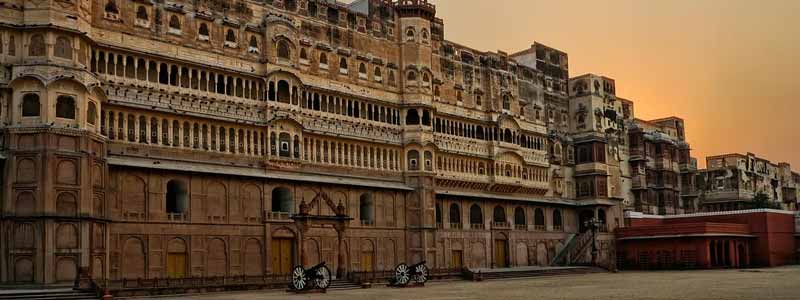
Junagarh Fort, Bikaner
Junagarh Fort, located in Bikaner, Rajasthan, is an impressive example of Rajput military architecture and a significant historical landmark. Constructed between 1588 and 1593 by Raja Rai Singh, the fort is renowned for its grand design, extensive courtyards, and intricate decorations.
Unlike many other forts in Rajasthan, Junagarh Fort is not situated on a hill but on a plain, which adds to its unique character. The fort’s architecture is a blend of Rajput, Mughal, and Gujarati styles, reflecting the diverse influences on its design. It is surrounded by a formidable moat and features a series of gates, including the main entrance, Karan Pol.
Inside the fort, visitors can explore a series of stunning palaces and halls, including the Diwan-i-Khas (Hall of Private Audience), with its ornate mirror work and intricate carvings. The Anup Mahal (Palace of the Anup) is noted for its elegant interiors and fine artwork. The fort also houses a museum with a collection of artifacts, including royal costumes, weapons, and artworks.
The fort’s interior is adorned with elaborate frescoes, marble carvings, and vibrant murals, showcasing the opulence of the Rajput rulers. Junagarh Fort offers a glimpse into the grandeur of Bikaner’s past and is a testament to the architectural and artistic achievements of the region.
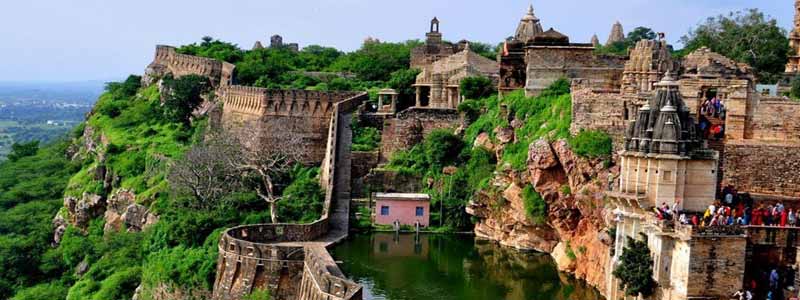
Chittorgarh Fort, Chittorgarh
Chittorgarh Fort, located in Chittorgarh, Rajasthan, is one of the largest and most historic forts in India. Spanning approximately 700 acres, the fort is a UNESCO World Heritage Site and stands as a symbol of Rajput valor and pride. Built in the 7th century by the Maurya dynasty, the fort has been a crucial site in Rajasthan’s history, enduring several battles and sieges.
The fort’s architecture is a blend of Hindu and Rajput styles, with an array of impressive structures including palaces, temples, and gateways. Notable within the fort are the Vijay Stambh (Victory Tower), built by Rana Kumbha to commemorate his victory over the Sultan of Malwa; and the Kirti Stambh (Tower of Fame), dedicated to the Jain Tirthankara Adinatha.
The fort complex also features the Rana Kumbha Palace, the residence of the Rajput kings, which includes the renowned Queen’s quarters. The Rani Padmini Palace, associated with the legendary queen Padmini, and the massive water reservoirs like the Gaumukh Reservoir are significant highlights.
Chittorgarh Fort is renowned for its historical tales of bravery, including the legendary Jauhar (mass self-immolation) by Rajput women to avoid capture by invaders. The fort’s imposing walls, grand gateways, and ancient structures reflect the resilience and grandeur of the Rajput era, making it a must-visit destination for history enthusiasts and cultural travelers.
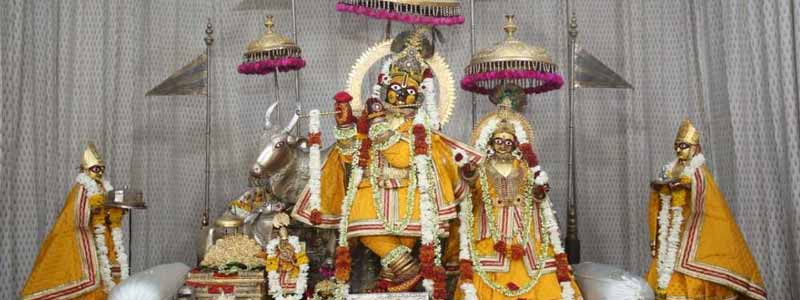
Govind Devji Temple, Jaipur
Govind Devji Temple, located in the heart of Jaipur, is a significant and revered Hindu temple dedicated to Lord Krishna. Constructed in the 18th century by Maharaja Sawai Jai Singh II, the founder of Jaipur, the temple holds a special place in the city’s spiritual and cultural landscape.
The temple is renowned for its elegant architecture, featuring intricate carvings, beautifully adorned pillars, and a spacious courtyard. The deity of Lord Krishna is worshipped here in the form of Govind Devji, and the temple is famous for its vibrant and lively celebrations of various Hindu festivals, especially Janmashtami, the birthday of Lord Krishna.
One of the unique aspects of the temple is its exquisite decorations and the ornate attire of the deity, which changes according to the time of day and season. The temple’s ambiance is both serene and devotional, drawing numerous devotees and tourists alike.
The Govind Devji Temple is located within the City Palace complex, adding to its historical and architectural significance. Its central location and rich cultural heritage make it a prominent landmark in Jaipur, offering visitors a glimpse into the religious and artistic traditions of the region.
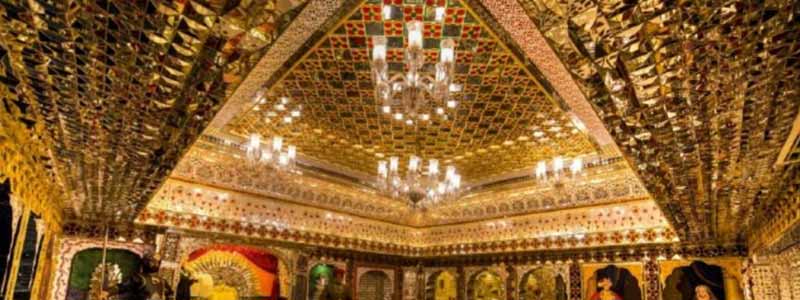
Sheesh Mahal (Hall of Mirrors), Jaipur
Sheesh Mahal, or the Hall of Mirrors, is a stunning architectural marvel located in the Amber Fort, Jaipur. Built in the 16th century by Raja Man Singh I and later expanded by successive rulers, the Sheesh Mahal is renowned for its intricate mirror work and opulent design.
The hall is known for its elaborate decoration, with walls and ceilings adorned with thousands of tiny mirrors embedded in marble. The mirrors create a dazzling effect when light is reflected, giving the room a sparkling and almost ethereal appearance. This effect was designed to mimic the appearance of a starry night sky, adding to the grandeur of the palace.
The Sheesh Mahal was used as a private chamber for the royal family and is located in a secluded part of the fort, providing privacy and luxury. The room’s design reflects a blend of Rajput and Mughal architectural styles, featuring ornate carvings, floral patterns, and geometric designs.
The Hall of Mirrors is a highlight of Amber Fort, showcasing the exquisite craftsmanship and artistic vision of the Rajput era. It remains a popular attraction for visitors, offering a glimpse into the opulent lifestyle of the Maharajas and the intricate beauty of historical Indian architecture.
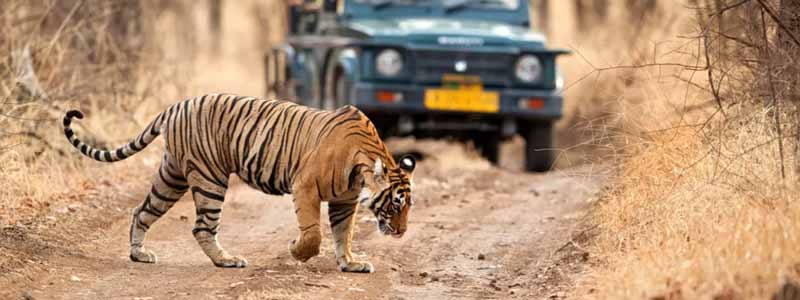
Ranthambore National Park, Sawai Madhopur
Ranthambore National Park, located in Sawai Madhopur, Rajasthan, is one of India’s most renowned wildlife sanctuaries and a prime destination for wildlife enthusiasts and photographers. Established as a national park in 1980, it covers an area of approximately 1,334 square kilometers and is known for its rich biodiversity and historical significance.
The park is famous for its population of Bengal tigers, offering excellent opportunities for tiger sightings. Ranthambore is part of the Ranthambore Tiger Reserve and is one of the best places in India to spot these majestic big cats in their natural habitat. In addition to tigers, the park is home to a variety of other wildlife species, including leopards, sloth bears, sambar deer, chital, and wild boars.
Ranthambore National Park also features a range of bird species, making it a popular spot for birdwatching. The park’s diverse landscapes, which include grasslands, forests, and water bodies, support a wide variety of flora and fauna.
One of the unique aspects of Ranthambore is the historic Ranthambore Fort, which stands atop a hill within the park. The fort, a UNESCO World Heritage Site, adds a historical and cultural dimension to the wildlife experience. It offers panoramic views of the park and its surroundings.
Visitors to Ranthambore can explore the park through guided jeep or canter safaris, which provide a chance to experience the park’s natural beauty and wildlife up close. The park’s rich history, diverse wildlife, and scenic landscapes make it a must-visit destination for nature lovers and adventure seekers.
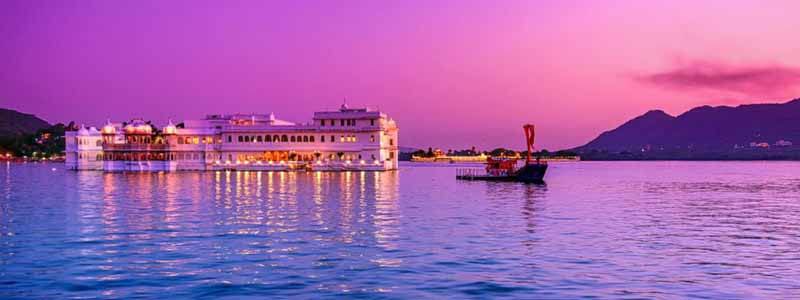
Lake Pichola, Udaipur
Lake Pichola, situated in the heart of Udaipur, Rajasthan, is one of the city’s most picturesque and iconic landmarks. Created in the 14th century by Maharana Udai Singh II, the lake has since become a central feature of Udaipur’s scenic beauty and cultural charm. Spanning approximately 7 kilometers in length and 2.5 kilometers in width, the lake is surrounded by hills, palaces, and gardens, offering breathtaking views and a serene atmosphere.
The lake is renowned for its two main islands: Jag Mandir and the Lake Palace. Jag Mandir, also known as the “Lake Garden Palace,” was built in the 17th century and served as a royal retreat. Its stunning marble architecture and lush gardens make it a popular spot for visitors. The Lake Palace, now a luxury hotel, was originally constructed as a summer residence for the Maharajas and is known for its elegant design and floating appearance on the lake’s surface.
Boat rides on Lake Pichola are a popular way to explore the lake’s beauty and to enjoy views of the surrounding landmarks. The lake’s reflective waters create a picturesque setting, especially during sunrise and sunset. The area around Lake Pichola, with its vibrant markets and historic buildings, adds to the charm of Udaipur, making it a must-visit destination for travelers seeking a blend of natural beauty and cultural heritage.
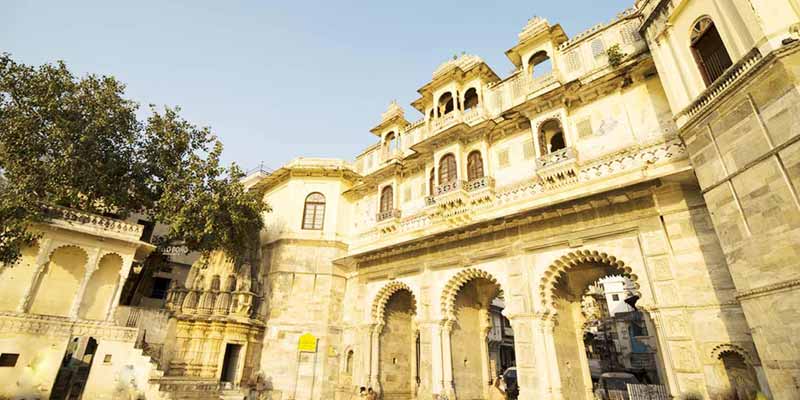
Bagore Ki Haveli, Udaipur
Bagore Ki Haveli, located on the eastern banks of Lake Pichola in Udaipur, is a historic mansion and a significant cultural landmark in Rajasthan. Built in the 18th century by Maharaja Shakti Singh, the younger brother of Maharaja Rana Singh, the haveli is a prime example of traditional Rajput architecture and offers a glimpse into the opulent lifestyle of the royal family.
The haveli is renowned for its ornate and intricately designed rooms, which feature stunning frescoes, mirror work, and carvings. Its architecture showcases a blend of Mughal and Rajput styles, with courtyards, balconies, and intricately decorated walls. The main attractions within the haveli include the grand Darbar Hall (Audience Hall), which is adorned with beautiful chandeliers and regal decor, and the impressive collection of royal artifacts, costumes, and jewelry.
Bagore Ki Haveli also hosts a popular cultural show in the evenings, known as the Bagore Ki Haveli Museum’s Evening Dance Show. This vibrant performance features traditional Rajasthani dance forms, music, and folk theater, providing visitors with an immersive experience of local culture and traditions.
The haveli’s location offers picturesque views of Lake Pichola, adding to its charm. With its rich history, architectural splendor, and cultural performances, Bagore Ki Haveli is a must-visit destination for those exploring the cultural heritage of Udaipur.
Pushkar Yoga Garden, Pushkar
Pushkar Yoga Garden, located in Pushkar, Rajasthan, is a serene retreat dedicated to promoting wellness and spiritual growth through yoga and meditation. Nestled in a tranquil environment, the garden offers a peaceful escape from the bustle of everyday life and provides a range of yoga and wellness programs for visitors.
The garden is known for its lush surroundings, which create a calming atmosphere conducive to relaxation and self-discovery. It provides various yoga classes, workshops, and retreats, catering to practitioners of all levels, from beginners to advanced. The programs typically include traditional yoga practices such as Hatha Yoga, Vinyasa, and Ashtanga, as well as meditation sessions and holistic therapies.
In addition to yoga sessions, Pushkar Yoga Garden often offers additional wellness activities like Ayurveda consultations, detox programs, and wellness workshops. The center emphasizes a holistic approach to health, combining physical exercise with mental and spiritual well-being.
Pushkar Yoga Garden also features comfortable accommodations, allowing guests to stay on-site and immerse themselves fully in the yoga experience. The garden’s peaceful ambiance, skilled instructors, and comprehensive wellness programs make it a popular destination for those seeking to rejuvenate their body, mind, and spirit in the heart of Pushkar.
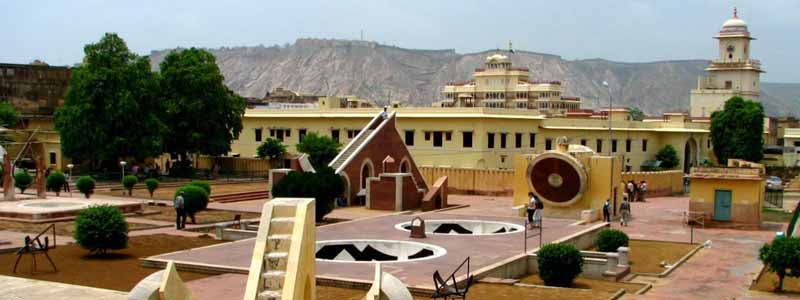
Jantar Mantar, Jaipur
Jantar Mantar in Jaipur is an impressive astronomical observatory built in the early 18th century by Maharaja Sawai Jai Singh II, the founder of Jaipur. It is one of five such observatories constructed by the Maharaja across India, with the Jaipur site being the largest and best preserved.
The observatory is renowned for its collection of astronomical instruments, each designed for precise observations of celestial events. The most notable of these is the Samrat Yantra, a massive sundial that measures time to an accuracy of about two seconds. Another significant instrument is the Jantar Mantar, a large armillary sphere used for tracking the positions of stars and planets.
The complex includes several other instruments such as the Rashivalaya Yantra, which measures the position of the sun, and the Chakra Yantra, used for determining the celestial altitude. The Jantar Mantar’s unique architectural and scientific features highlight the advanced knowledge of astronomy during the 18th century.
The observatory’s architectural style combines both functional and aesthetic elements, featuring intricate stone carvings and large geometric shapes. Its precise measurements and innovative design have earned it a place as a UNESCO World Heritage Site, reflecting its historical and scientific significance.
Jantar Mantar is not only a testament to India’s rich astronomical heritage but also a popular tourist attraction, offering visitors insight into the historical advancements in science and technology.
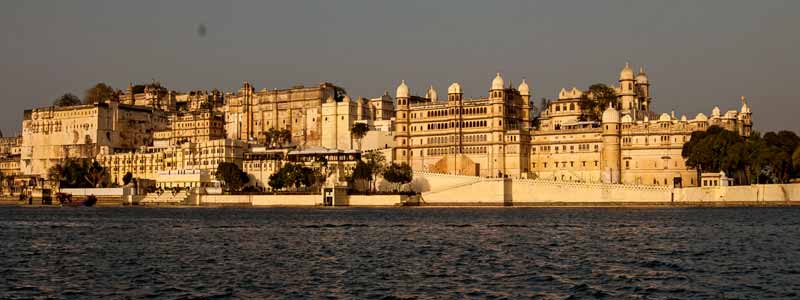
City Palace of Udaipur
The City Palace of Udaipur, perched on the eastern banks of Lake Pichola, is a magnificent example of Rajput architecture and one of Rajasthan’s most iconic landmarks. Constructed over a period of nearly 400 years, the palace complex was initiated by Maharana Udai Singh II in the 16th century and later expanded by subsequent Mewar rulers.
The palace features a stunning blend of Rajput, Mughal, and European architectural styles, characterized by its intricate peacock mosaics, ornate arches, and beautiful courtyards. The complex includes several palaces, courtyards, gardens, and balconies, offering spectacular views of the lake and the surrounding city.
Key highlights of the City Palace include the Chandra Mahal, which houses a museum with an impressive collection of royal artifacts, paintings, and historical memorabilia; and the Zenana Mahal, known for its exquisite interiors and intricate mirror work. The Jagmandir Palace, situated on an island in Lake Pichola, is another notable structure within the complex, offering a serene retreat and stunning vistas.
The palace’s grandeur and historical significance reflect the opulence and cultural heritage of the Mewar dynasty. Its well-preserved architecture and extensive collection of royal artifacts make it a must-visit destination, providing visitors with a glimpse into the regal history and artistic achievements of Udaipur’s past.
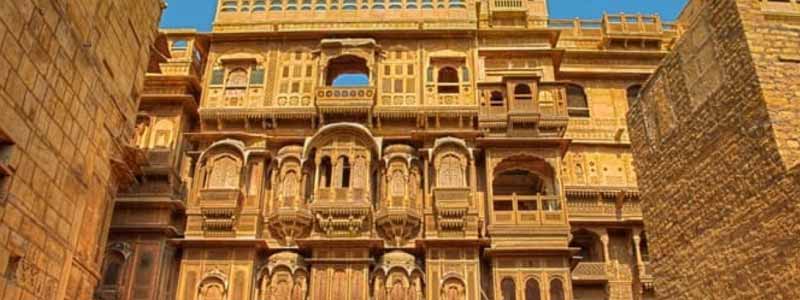
Patwon-ki-Haveli, Jaisalmer
Patwon-ki-Haveli, located in Jaisalmer, Rajasthan, is a remarkable example of the opulent architecture and intricate craftsmanship of the region. Constructed in the 19th century by a wealthy merchant named Guman Chand Patwa, the haveli is renowned for its stunning facades and ornate detailing.
The haveli consists of five interconnected havelis, each showcasing elaborate carvings, exquisite mirror work, and delicate jharokhas (overhanging enclosed balcony). The detailed stonework, with its intricate patterns and delicate filigree, reflects the artistic prowess of the artisans of that era. The facade of the haveli is adorned with beautiful sandstone carvings depicting various themes, including floral patterns and mythological figures.
One of the standout features of Patwon-ki-Haveli is its grand entrance and the intricately designed courtyards, which include the Kothari’s Mahal, known for its impressive ceilings and detailed frescoes. The haveli also includes several rooms with intricate woodwork and elaborate decor, providing insight into the luxurious lifestyle of the merchant families during that period.
Today, Patwon-ki-Haveli serves as a museum and a popular tourist attraction, offering visitors a glimpse into the rich cultural and architectural heritage of Jaisalmer. Its historical significance and architectural beauty make it a must-visit destination for those exploring the golden city of Jaisalmer.
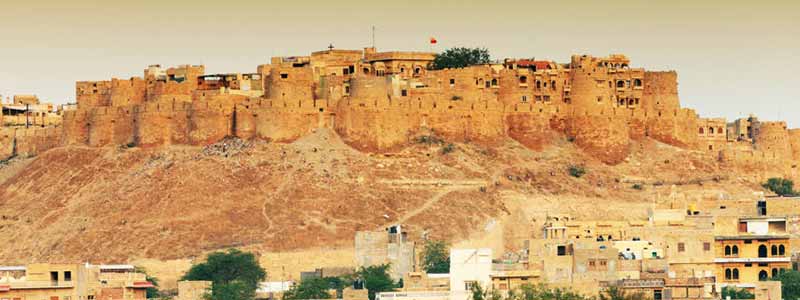
Jaisalmer Fort, Jaisalmer
Jaisalmer Fort, also known as Sonar Quila or the Golden Fort, is a magnificent fort located in the city of Jaisalmer, Rajasthan. Built in 1156 AD by Maharawal Jaisal Singh, the fort is renowned for its stunning yellow sandstone architecture, which gives it a golden hue, especially at sunset.
The fort is one of the largest and most well-preserved forts in India and is a UNESCO World Heritage Site. It stands atop a hill, overlooking the Thar Desert, and its imposing walls, intricate carvings, and massive gateways are notable features. The fort’s architecture reflects a blend of Rajput and Islamic styles, with elaborate jharokhas (overhanging balconies), ornate arches, and detailed stonework.
Inside the fort, visitors can explore a maze of narrow lanes, bustling with vibrant bazaars, traditional havelis, and temples. The fort complex includes several important structures such as the Raj Mahal (Royal Palace), which was the residence of the Maharajas; the Laxminath Temple, dedicated to Hindu deities; and the Jain Temples, known for their exquisite carvings.
Jaisalmer Fort also features a series of well-preserved bastions and watchtowers, which offer panoramic views of the surrounding desert landscape. The fort’s living heritage, architectural grandeur, and historical significance make it a must-visit destination for those exploring Rajasthan’s cultural and architectural marvels.
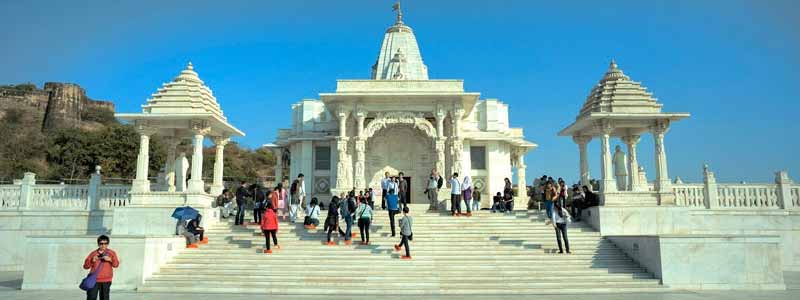
Birla Mandir Temple, Jaipur
Birla Mandir Temple in Jaipur, also known as Lakshmi Narayan Temple, is a stunning modern Hindu temple dedicated to Lord Vishnu and Goddess Lakshmi. Located on the Moti Dungari Hill, the temple offers panoramic views of the city and stands as a symbol of architectural elegance and religious devotion.
Built by the Birla family, prominent industrialists, in 1988, the temple is renowned for its impressive white marble architecture and intricate carvings. The exterior of the temple features beautiful sculptures and intricate patterns, while the interior boasts a serene and peaceful atmosphere. The main shrine houses idols of Lord Vishnu and Goddess Lakshmi, crafted from marble, and is surrounded by detailed artwork and carvings.
The temple’s architecture combines traditional and modern styles, with a grand entrance, elegantly designed domes, and well-maintained gardens. The serene ambiance and elevated location make it a popular spot for both worship and sightseeing.
In addition to its religious significance, Birla Mandir Temple serves as a cultural landmark, hosting various festivals and religious ceremonies throughout the year. Its architectural beauty, tranquil setting, and spiritual atmosphere make it a prominent destination for visitors in Jaipur.
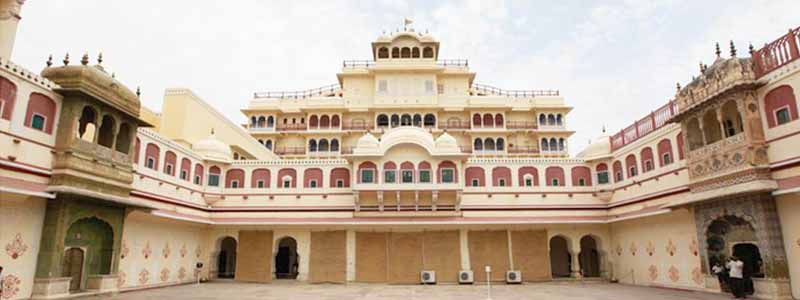
City Palace of Jaipur, Jaipur
The City Palace of Jaipur is a grand architectural marvel and a significant historical landmark located in the heart of Jaipur, Rajasthan. Built by Maharaja Sawai Jai Singh II, the founder of Jaipur, the palace complex reflects the opulence and grandeur of the Rajput era and showcases a blend of Rajput, Mughal, and European architectural styles.
The palace complex consists of several buildings, courtyards, and gardens, with the main structures including the Chandra Mahal (Moon Palace) and the Mubarak Mahal (Welcome Palace). The Chandra Mahal, which serves as the primary residence of the current royal family, is adorned with intricate frescoes, mirror work, and elaborate interiors. The Mubarak Mahal, originally a reception hall, now houses the Maharaja Sawai Man Singh II Museum, which displays a collection of royal artifacts, costumes, and artworks.
The Diwan-i-Am (Hall of Public Audience) and Diwan-i-Khas (Hall of Private Audience) are notable for their elegant arches, decorative ceilings, and rich interiors. The Baggi Khana, a section of the palace dedicated to the display of royal carriages and palanquins, showcases the grandeur of the Maharajas’ transportation.
The City Palace is also known for its beautiful gardens, such as the Pritam Niwas Chowk, which features vibrant tilework and floral patterns. The palace complex offers panoramic views of the city and serves as a popular tourist destination, providing insights into Jaipur’s royal heritage and architectural splendor.
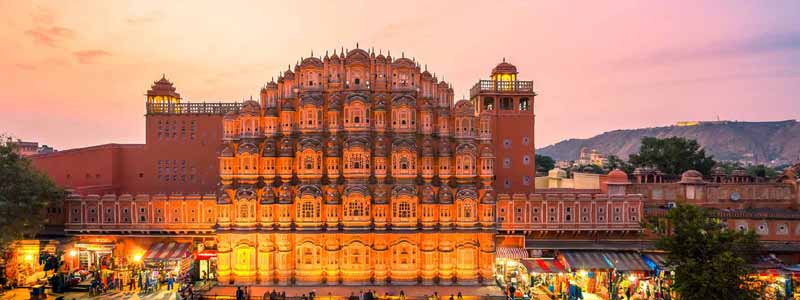
Hawa Mahal, Jaipur
Hawa Mahal, also known as the “Palace of Winds,” is one of Jaipur’s most iconic landmarks and a striking example of Rajput architecture. Constructed in 1799 by Maharaja Sawai Pratap Singh, the palace is renowned for its unique façade and intricate design.
The building’s most distinctive feature is its façade, which resembles a honeycomb or a beehive with its numerous small windows or “jharokhas.” These windows are adorned with intricate latticework, allowing royal women to observe street life and festivities without being seen themselves. The design was intended to provide ventilation and cooling, earning the palace its name, “Hawa Mahal,” which translates to “Palace of Winds.”
Hawa Mahal is made of red and pink sandstone, which adds to its aesthetic charm. The façade is a five-story structure with a series of ornate balconies and delicate carvings. While the exterior is highly decorative, the interior is more modest, consisting of a series of corridors and rooms that were used primarily for observing the activities below.
The palace’s location on the edge of the City Palace complex provides panoramic views of Jaipur’s bustling streets and surrounding landscape. Its architectural beauty and historical significance make Hawa Mahal a must-visit attraction for those exploring the cultural and architectural heritage of Jaipur.
Jag Mandir, Udaipur
Jag Mandir, also known as the “Lake Garden Palace,” is a stunning island palace situated on Lake Pichola in Udaipur, Rajasthan. Constructed during the 17th century, it was initially built by Maharaja Jagat Singh I and later expanded by his successors, including Maharaja Bhim Singh II.
The palace is renowned for its serene setting and beautiful architecture. Made of marble and set on an island in Lake Pichola, Jag Mandir offers picturesque views of the lake and the surrounding landscape. Its design combines Rajput and Mughal architectural styles, featuring elegant domes, intricately carved marble pillars, and expansive courtyards.
One of the notable features of Jag Mandir is its Garden Courtyard, which includes lush gardens, fountains, and statues, providing a tranquil retreat from the bustling city. The palace also houses the Jal Darwaza (Water Gate), which is accessed by a boat ride from the city, adding to its allure and exclusivity.
Jag Mandir’s serene environment and exquisite design make it a popular destination for visitors seeking a peaceful escape and a glimpse into Udaipur’s royal heritage. It is often used as a venue for special events and ceremonies, including weddings, due to its picturesque setting and historical charm.
Karni Mata Temple, Deshnok
Karni Mata Temple, located in Deshnok near Bikaner, Rajasthan, is a unique and renowned Hindu temple dedicated to Karni Mata, a revered local deity believed to be an incarnation of the goddess Durga. The temple is famously known as the “Temple of Rats” due to the large number of rats that inhabit it.
Constructed in the 15th century, the temple is an architectural marvel with intricate marble work and a stunning entrance adorned with detailed carvings. The sanctum sanctorum houses the idol of Karni Mata, and the temple is noted for its elaborate silver and marble decorations.
The most distinctive feature of the temple is its resident population of rats, which are considered sacred. Devotees believe that these rats are the reincarnated souls of the goddess’s devotees. The rats are fed and protected, and they roam freely throughout the temple complex. Pilgrims and visitors regard it as auspicious to encounter a rat, and many offer food and milk to the rodents as a form of worship.
The temple’s unique tradition and its association with the rats draw both pilgrims and curious visitors. The annual festival of Karni Mata, held in March or April, is a major event that attracts large crowds and features various religious and cultural activities. The Karni Mata Temple stands as a testament to the rich and diverse traditions of Rajasthan.
Nahargarh Fort, Jaipur
Nahargarh Fort, situated on the Aravalli Hills overlooking Jaipur, is a historic fortification with a blend of architectural and scenic beauty. Built in 1734 by Maharaja Sawai Jai Singh II, the founder of Jaipur, the fort was initially constructed as a retreat and pleasure palace for the royal family.
The fort’s design reflects a fusion of Indian and European architectural styles, with ornate interiors, spacious courtyards, and vibrant frescoes. It features a series of rooms and balconies that offer panoramic views of the surrounding landscape and the city of Jaipur.
Nahargarh Fort is known for its charming atmosphere and historical significance. The palace within the fort, known as the Maharaja’s Palace, includes well-preserved rooms adorned with intricate decorations and paintings. The fort also includes a series of gardens and open spaces, providing a serene setting for relaxation and leisure.
The fort’s elevated location and its picturesque surroundings make it a popular spot for visitors to enjoy stunning sunsets and panoramic views of Jaipur. It has become a favored destination for both tourists and locals, offering a glimpse into the royal lifestyle and a tranquil escape from the city’s hustle and bustle. Nahargarh Fort’s combination of historical charm, architectural splendor, and scenic beauty makes it a must-visit attraction in Jaipur.
Jal Mahal, Jaipur
Jal Mahal, or the “Water Palace,” is an enchanting palace situated in the middle of Man Sagar Lake in Jaipur, Rajasthan. Constructed in the 18th century by Maharaja Sawai Jai Singh II, the palace was designed as a retreat and hunting lodge for the royal family.
The architectural style of Jal Mahal is a stunning blend of Rajput and Mughal designs. The palace, made of pink sandstone, features a series of beautiful domes, arched windows, and intricate carvings. Its most striking feature is its setting—rising gracefully from the center of the lake, creating a mesmerizing reflection that adds to its beauty.
The palace has five stories, with four of them submerged underwater when the lake is full, enhancing its ethereal appearance. The upper story, visible from the shore, is adorned with elaborate decorations and offers splendid views of the lake and the surrounding hills.
Jal Mahal is not open to the public for interior tours, but visitors can enjoy boat rides on Man Sagar Lake to view the palace from a distance. The picturesque setting and unique architecture make it a popular spot for photography and sightseeing. The palace’s romantic allure and serene surroundings make it a favorite destination for those exploring Jaipur’s heritage and natural beauty.
Alwar City Palace, Alwar
Alwar City Palace, located in the city of Alwar in Rajasthan, is a historic and architectural gem that reflects the grandeur of the Rajput era. The palace, situated in the heart of the city, was built by the rulers of the Alwar princely state, particularly during the reign of Maharaja Jai Singh.
The palace is known for its impressive architectural style, which combines elements of Rajput and Mughal designs. It features intricate marble and sandstone carvings, spacious courtyards, and beautifully decorated rooms. The palace complex includes various sections such as the Rani Mahal (Queen’s Palace), Maharaja’s Palace, and the Zenana Mahal (Women’s Quarters), each showcasing exquisite craftsmanship and elegant design.
The palace also houses a museum, known as the Government Museum, which displays a collection of artifacts, including historical manuscripts, paintings, and sculptures. This museum offers insights into the rich cultural and artistic heritage of Alwar.
The palace’s location and architecture provide a glimpse into the royal lifestyle of the Alwar rulers, making it a significant historical and cultural landmark in the region. Its blend of architectural styles, historical significance, and cultural exhibits make it a noteworthy destination for visitors exploring the heritage of Alwar.
The Ajmer Sharif Dargah, Ajmer
The Ajmer Sharif Dargah, located in Ajmer, Rajasthan, is one of the most revered Sufi shrines in India. Dedicated to Garib Nawaz, the revered Sufi saint Khwaja Moinuddin Chishti, the dargah attracts millions of devotees and visitors from across the world.
Built in the 13th century by Emperor Akbar, the dargah complex is a significant pilgrimage site for Muslims and people of various faiths. The shrine features an impressive architectural design, with a large courtyard surrounded by intricately decorated halls and domes. The main shrine, where the saint’s tomb is located, is an ornate structure adorned with marble and gold embellishments.
Visitors to the Ajmer Sharif Dargah can participate in the daily rituals and prayers. The site is renowned for its serene atmosphere and the sense of spiritual solace it offers. The dargah also hosts several annual festivals, including the Urs, which commemorates the death anniversary of Khwaja Moinuddin Chishti. During the Urs, the dargah is bustling with devotional activities, processions, and celebrations.
The Ajmer Sharif Dargah is a symbol of communal harmony and spiritual unity, drawing people from diverse backgrounds to pay their respects and seek blessings. Its architectural splendor, historical significance, and the deep reverence it commands make it a key cultural and religious landmark in Rajasthan.
Rampuria Haveli, Bikaner
Rampuria Haveli, located in Bikaner, Rajasthan, is a striking example of traditional Rajasthani architecture and heritage. Built by the Rampuria family, who were prominent merchants in the 19th century, the haveli stands as a testament to their wealth and architectural taste.
The haveli is renowned for its elaborate and intricate design, featuring ornate carvings, beautiful frescoes, and delicate jharokhas (overhanging balconies). Its façade is adorned with detailed sandstone work and intricate lattice designs, showcasing the skilled craftsmanship of the time. The haveli’s architecture reflects a blend of Rajput and Mughal styles, with its richly decorated interiors and spacious courtyards.
One of the highlights of Rampuria Haveli is its Bhootnath Temple, located within the premises. The temple adds a spiritual dimension to the haveli and is known for its intricate carvings and serene ambiance.
The haveli is an excellent example of the opulent lifestyle of Bikaner’s merchant class during the 19th century. Although it is privately owned, its architectural splendor and historical significance make it a notable landmark in Bikaner, offering a glimpse into the city’s rich cultural and architectural heritage.
Sajjan Garh Palace, Udaipur
Sajjan Garh Palace, also known as the Monsoon Palace, is a majestic hilltop palace located in Udaipur, Rajasthan. Perched on the Bansdara Peak of the Aravalli Range, the palace offers panoramic views of the surrounding landscape, including the city of Udaipur and the nearby lakes.
Constructed in the late 19th century by Maharaja Sajjan Singh, the palace was originally intended as a retreat for the royal family to observe the monsoon rains and enjoy the natural beauty of the region. The palace’s design reflects a blend of Rajput and Mughal architectural styles, with its intricate carvings, spacious courtyards, and grand domes.
The palace features a combination of elegant rooms, including the Durbar Hall (Audience Hall), which showcases the opulence of the Maharaja’s lifestyle. The terrace of the palace provides stunning sunset views, making it a popular spot for visitors seeking a picturesque setting.
Sajjan Garh Palace is surrounded by lush greenery and is located near several lakes, including the Fateh Sagar Lake. The palace’s elevated position and serene environment make it an ideal spot for relaxing and enjoying the scenic beauty of the region. Its architectural charm and panoramic views make it a significant landmark in Udaipur and a must-visit for those exploring the city’s royal heritage.
Bhangarh Fort, Alwar
Bhangarh Fort, located near Alwar in Rajasthan, is one of India’s most famous and reportedly haunted fortresses. Built in the 17th century by Maharaja Madho Singh I, the fort is renowned for its imposing ruins and its association with various legends and supernatural tales.
The fort complex includes several temples, palaces, and residential quarters, showcasing a blend of Rajput and Mughal architectural styles. Despite its once-grand design, the fort now stands largely in ruins, with many of its structures, such as the Rani Mahal (Queen’s Palace), Sukh Niwas (Pleasure Garden), and Keshav Rai Temple, showing signs of age and decay.
Bhangarh Fort is enveloped in local folklore, with tales of curses and paranormal activity that attract numerous visitors and thrill-seekers. According to legend, the fort was cursed by a sorcerer who fell in love with a princess of the fort. The curse allegedly led to the downfall of the fort and its inhabitants. The fort is said to be haunted, and entry is prohibited after sunset and before sunrise, adding to its eerie reputation.
Despite its spooky lore, Bhangarh Fort is also appreciated for its historical significance and its picturesque setting amidst the Aravalli Range. The fort’s dramatic ruins against the backdrop of the hills create a compelling and atmospheric site for history enthusiasts and adventurers.
Kuldhara Village, Jaisalmer
Kuldhara Village, located near Jaisalmer in Rajasthan, is an ancient, abandoned village that holds a significant place in local folklore and history. Founded in the 13th century by the Paliwal Brahmins, Kuldhara was once a thriving settlement with well-planned streets, houses, and temples.
The village was known for its advanced water management system, including wells and reservoirs, which helped sustain its inhabitants in the arid desert environment. However, Kuldhara was mysteriously abandoned in the early 19th century, and the reasons behind its desertion are the subject of various legends and myths.
One popular legend suggests that the village was cursed by a minister of the then-ruler of Jaisalmer, who fell in love with a local princess. When the love affair was rejected, the minister allegedly placed a curse on the village, leading to its abandonment. This story contributes to the village’s reputation as a haunted place.
Today, Kuldhara is a popular tourist attraction, known for its eerie, deserted ambiance and well-preserved ruins. The village’s architectural remnants, including old houses, temples, and streets, provide a fascinating glimpse into its past. Visitors often explore the site to experience its historical significance and to delve into the intriguing legends that surround it. The village’s haunting atmosphere and historical ruins make it a unique and captivating destination near Jaisalmer.
Foy Sagar Lake, Ajmer
Foy Sagar Lake, located in Ajmer, Rajasthan, is an artificial lake built in 1892. It was constructed under the guidance of a British engineer named Mr. Foy to provide a water source for the region and to help combat the water scarcity issues in the area.
The lake is set against the backdrop of the Aravalli Range, offering picturesque views and a tranquil environment. It is surrounded by well-maintained gardens and landscaped areas, making it a pleasant spot for relaxation and picnics. The serene waters of the lake are a refreshing sight, particularly in the arid region of Rajasthan.
Foy Sagar Lake also features a few small temples and monuments around its perimeter, adding to its charm and historical significance. While the lake itself is primarily functional, its scenic beauty and peaceful ambiance make it a popular destination for both locals and visitors.
The lake is an excellent example of early engineering efforts in water management and provides a serene retreat away from the bustling city of Ajmer. Its historical value, coupled with its natural beauty, makes it a notable attraction for those exploring the region.
Moosi Maharani Ki Chhatri, Alwar
Moosi Maharani Ki Chhatri, located in Alwar, Rajasthan, is a remarkable example of Rajasthani architecture and commemorates the legacy of a royal consort. Built in the 19th century by Maharaja Bakhat Singh in honor of his queen, Moosi Maharani, the chhatri (cenotaph) is an elegant structure situated amidst lush gardens.
The chhatri features a blend of Rajput and Mughal architectural styles, with its intricately carved marble pillars, arches, and domes. The structure is elevated on a platform, providing a grand view of the surrounding area. The beautiful carvings and detailed artwork on the chhatri highlight the craftsmanship of the era.
Moosi Maharani Ki Chhatri is set within a picturesque garden, adding to its serene and tranquil atmosphere. The gardens, with their well-maintained pathways and water features, enhance the beauty of the chhatri and provide a peaceful retreat for visitors.
The cenotaph is not only an important historical monument but also an architectural delight, showcasing the artistic and cultural heritage of the region. Its significance as a memorial and its aesthetic appeal make it a noteworthy attraction for those exploring the historical and cultural landmarks of Alwar.

